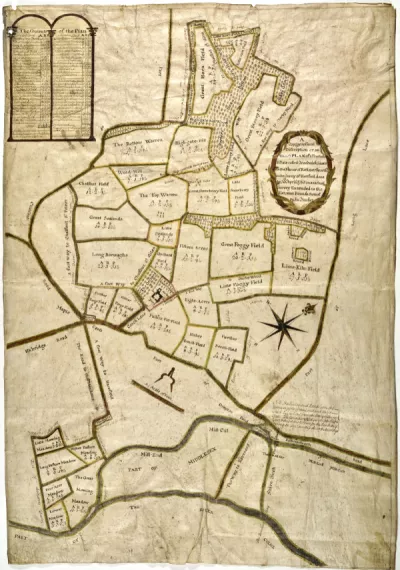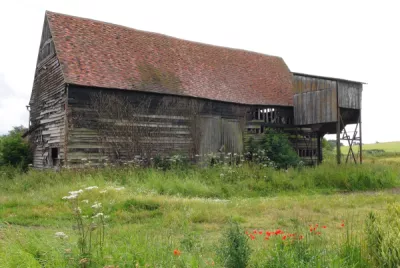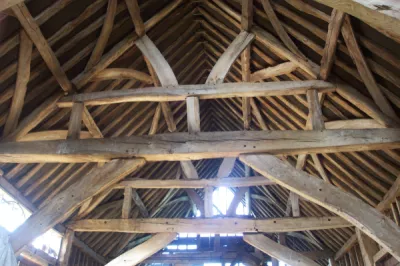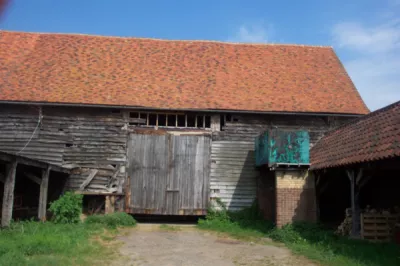The story of Woodoaks Farm
An ancient manor and farm, now continuing refreshed

Woodwick Manor to Woodoaks Farm
This article is taken extensively from the research of Adrienne Jacques, published in Newsletter Number 90 of the Rickmansworth Historical Society (December 2010), pp.3-15.
Woodwyck, or Woodwick or Woodoaks, was sold only once before 1847. The map you see here, dated 30 April 1760, was surveyed as part of that sale, which took place in 1761.
Woodoaks Farm still exists, and provides a reminder of the sort of farm which was until recently the mainstay of the agricultural economy in this area.
The Manor of Woodwyck
In the early middle ages Woodwyck (or Woodwick, later Woodoaks Farm) was a Knight’s Fee manor of the holdings of the Abbey of St Albans. It was one of several in the area held by a ‘knight’ in return for providing military support to an overlord, in this case the Abbey (to allow the abbot to discharge his duty to the king), and together about ‘five hides’, about 500 or 600 acres, in area – Woodwyck covering about 100 of those acres.
We can expand this a bit more. This was a consequence of a significant development of military technology - the mounted armoured fighting man. Before this soldiers had walked to battle, with their leaders riding but not fighting on horseback. Improvements in horse breeding developed animals strong enough to carry a man, and new armour and weapons allowed a man to fight on horseback - a formidable weapon system.
But this new technology was expensive. A collection of 'knights' (as they became known) with their horses, grooms, feed and acoutrements, armour and weapons cost more than a king was willing to pay unless actually required for war. So the requirement, across much of northern Europe, was contracted out to the owners of the land (especially the Abbeys), who might each be required to deliver a dozen or so knights. They couldn't afford to pay them either: but they had land, and the solution was to lease the knights parcels of land from which they took their livelihood until called to go to fight. They probably didn't usually farm it themselves, but rented it to a farmer - and took the rent.
And so it was for Woodwyk. From about 1160 it was in the hands of the de Wodewyck family. Late in the 13th century the Knights’ Fee manors wrre brought directly under the Crown, but the existing tenants, like the de Wodewycks, usually remained. But when the family succession failed in the mid-14th century the property probably reverted to the Abbey, who leased it out - the need to maintain fighting knights was waning. From the 1490s the tenants were families very well known in London, so the farming was done by sub-tenant farmers. After the dissolution of the monasteries in 1539 many such landholdings were taken by the crown, but at Wodewyck the existing tenant had already been allowed to purchase it directly and passed it to her descendants in a very extensive property portfolio.
In 1668, after the Civil War, the estate passed by marriage to the Tichborne family, well regarded at Court although relatively impoverished. Sir Benjamin Tichborne actually lived here with his family and became well known as local benefactors, although still a courtier. But none of his children married, and it was his last daughter Frances whose death in 1760 caused the estate to be sold on the open market for the first time. Her farm tenants John and Alice Sedgwick were treated generously in her will, and were to continue on the farm after the sale.
The estate sale and map
This map was surveyed by James Backer to support the sale - the original is kept at the Hertfordshire Archives.
Samuel Leightonhouse, a wealthy Londoner, bought several Rickmansworth properties including Money Hill House where he and his wife lived with their son and daughter. Woodwicks was an investment costing £4705, and he was happy for the Sedgwicks to stay on, granting them a 21 year lease.
He or his son (also Samuel) built a new farmhouse for the Sedgwicks. Mr Leightonhouse also purchased the 40 acre smallholding of Pullingspit, across the Uxbridge Road from Woodwicks adjoining the meadows, and added it to the Sedgwicks’ lease. Members of the Sedgwick family were to remain on the farm for nearly another hundred years.
The main woodland on the farm, now known by the name of Bottom Wood, was not originally part of the Woodwick estate. The Tichbornes had separately rented from the Manor of Rickmansworth 52 acres called Porters Dean, 20 acres called Woodman’s Field and 2 parcels of land at Drayton Ford. The Porters Dean acreage adjoined Woodwicks on the northern side and is described on the map as Porters Dean Bottom, Oaken Grove and Horn Field Wood. Although this holding is shown on the sale map, it seems that Samuel Leightonhouse had to buy it separately from the Manor of Rickmansworth.
At the time of the survey the estate covered just over 400 acres, a reasonable sized holding in Hertfordshire at that time.

The field names and descriptions are themselves of real interest. This, like most of the farms on the west side of the county and in south Buckinghamshire, was a reasonable mixed farm, with arable (wheat, oats and barley) crops grown on the slope above the river towards what's now the M25, and an area of wet meadowland in the valley. Cattle will have grazed there, and hay grown and mown as a crop. And there was a large area of woodland, which provided a very important cash crop.
The area immediately to the south of Woodwick is shown as belonging to Mr Howard of West Hyde farm, with 'Mrs Ivory’s' farm just to the north of it. The western neighbours are Bullsland farm and Horn Hill farm, the last also Mr Howard’s. To the west lies High Ash farm, to the north Herringers (Herringsgate) farm.
Round the outlying fields to the east of the Uxbridge Road, round Gulch Wells, are parts of Linsters and West Hyde farms.
The Howards operated Troy Mill as well, and after the Grand Junction canal came through they had a small number of boats taking grain and flour to London. The daughter of William Sedgwick, the tenant of Woodwick and steward for Samuel Leightonhouse whose father bought the estate at the sale for which this map was made, married Thomas Howard in about 1790, showing just how close the farming community was at this time.
The road and path network is clearly seen on the map, following many of the lines of roads we now recognise. We also notice how carefully the wooded strips alongside the fields are measured and marked, as ‘woodland hedge row’: the timber was a valuable resource, the management of which William Sedgwick was to become a real expert. The large woodland areas of Porters Dean Bottom, even in 1760, were carefully cultivated and harvested, providing a very important cash crop.

Arable Land on Woodoaks Farm, 1760
NB: 40 perches to 1 rood, 4 roods to an acre of 4840 sq yds (1 furlong x 1 chain)
Name | Acres | Roods | Perches |
Further Forge field | 5 | 2 | 6 |
Hither forge field | 6 | 0 | 19 |
Long Burrows | 23 | 3 | 31 |
Pullings Pitt field | 14 | 2 | 28 |
Hither Beech field | 8 | 3 | 9 |
Further beech field | 10 | 3 | 29 |
Eight Acres | 8 | 3 | 7 |
Fifteen acres | 15 | 2 | 9 |
Little Foggy field | 10 | 1 | 36 |
Great foggy field | 20 | 2 | 35 |
Lime Kiln Field | 27 | 1 | 31 |
The driving lanes, yards, orchards, gardens and house & buildings | 7 | 3 | 4 |
The Orchard field | 4 | 0 | 37 |
Little Sealands | 4 | 3 | 13 |
Great Sealands | 16 | 3 | 32 |
Chalfont field | 12 | 2 | 9 |
Wold-hill with the ruins | 7 | 1 | 18 |
The top warren with the ruins | 15 | 2 | 13 |
The Bottom warren | 17 | 2 | 38 |
High Gate Hill | 12 | 2 | 32 |
Great strawberry field | 13 | 3 | 29 |
Little strawberry field | 7 | 2 | 30 |
Little Stoney field | 5 | 0 | 29 |
Great stoney field | 22 | 0 | 38 |
Great Horn field | 14 | 2 | 7 |
Little Horn field | 4 | 3 | 23 |
Coach lane | 0 | 2 | 10 |
Total Arable land | 321 | 3 | 14 |
Meadow Land
Name | Acres | Roods | Perches |
Hither pasture Meadow | 4 | 0 | 25 |
Great mowing meadow | 11 | 0 | 20 |
Little mowing meadow | 3 | 2 | 37 |
Long pasture meadow | 8 | 0 | 18 |
The four acre meadow | 4 | 1 | 28 |
Lower meadow eight | 3 | 3 | 37 |
Willow eight at the gate | 0 | 1 | 18 |
Drayton Ford eight with the toft & land covered with water adjoining the same | 0 | 3 | 23 |
Total meadow land | 36 | 3 | 10 |
Wood Land
Name | Acres | Roods | Perches |
The Walk wood | 2 | 1 | 15 |
Foggy Field wood | 4 | 2 | 20 |
Fox Dells | 1 | 1 | 2 |
Lime kiln field hedgerow | 2 | 1 | 16 |
The upper round-a-bout | 0 | 3 | 4 |
The lower round-a-bout | 0 | 3 | 6 |
Bottom warren hedge row | 2 | 1 | 19 |
High Gate Hill hedge row | 0 | 2 | 11 |
Little stoney field hedge row | 0 | 3 | 24 |
L[ittle] Strawberry field hedge row | 0 | 3 | 12 |
G[reat] Horn field hedge row | 4 | 0 | 10 |
L[ittle] Horn field hedge row | 1 | 3 | 35 |
The wood land contained under the names of High Gate hill wood, Porters Dean bottom, Oaken grove and Horn Field Wood | 27 | 2 | 28 |
Total wood land | 50 | 2 | 5 |
Total area of Woodwick Farm in on 30 April 1760 | 409 | 0 | 30 |
The story after 1800 - the Sedgwicks
The story of Woodoaks to 1847 features the Sedgwick family very prominently, and their story too is of great significance locally.
After the deaths of his parents John and Alice their elder son William Sedgwick inherited and renewed the lease for another 21 years. William was the same age as the younger Samuel Leightonhouse, and as children they were encouraged to become friends. They may even have shared Samuel’s tutor, as William received a remarkable education for the son of a husbandman. It may be that William or his parents envisaged a career away from farming, but by the age of 19 he was married to Mary Saunders of St Albans and eight years later he had six children to support. Mary died in 1781, and a year later William married the daughter of an Ickenham yeoman farmer with whom he had a further six children.
Samuel Leightonhouse senior had died in 1768, and Samuel junior returned to London
leaving William Sedgwick as his agent for local business affairs. William dealt with the occasional leases of Leightonhouse property and was especially responsible for the woodland owned by Samuel Leightonhouse, becoming especially adept as an appraiser and surveyor of timber. The role of local woodlands was changing with the coming of the Grand Junction Canal, which halved the cost of coal for domestic use and provided a local surplus of timber which could be sold in London, often having been transported there by the same canal. There were only 50 acres of woodland on the Woodwick estate, but William's skills were called on over a much wider area.
William encouraged his children to seek careers away from the farm, and his eldest son John was apprenticed and later became a partner in a Kings Langley firm of Auctioneers. When this folded John and William set up an auctioneering and timber business, running the operation from the farm at Woodwicks. The business prospered and William’s reputation increased still further. It was about this time that he became a churchwarden of St Mary’s, Rickmansworth alongside his son-in-law Thomas Howard, and is recorded as such in 1803, when the church was repaired and beautified.
William Sedgwick died on 1 December 1816, aged 62, and was described in the ‘County Chronicle’ as "a man of the strictest integrity". In his will, where he states his profession as Auctioneer, he bequeathed £500 to his widow plus an annuity of £15. His two unmarried daughters also received £500, the two married ones having received their share when they married. £500 was a substantial sum at the time, almost equal to a year’s rent on the combined Woodwicks and Pullingspit farms. The farm implements and the remainder of the farm leases were bequeathed to his two surviving sons, one fourth to John who no doubt had received his patrimony for the auctioneering business, and three fourths to James who never married but who became the mainstay of Woodwicks Farm. 'Old Mr James' was a close associate of John White of Parsonage Farm: he referred to him as 'Uncle Jim', noted his death in March 1868 and was at the funeral.
John Sedgwick, William’s heir, married in 1809. They probably set up home at Pullingspit Farm and over the years five boys and four girls were born to them. John continued to develop the auctioneering business, but he also kept his land and surveying interests and became a landed estate agent. Notable sales included Langley House, his father-in law’s Corn and Paper Mills in Kent and Maple Cross Farm adjoining Woodoaks. His eldest son joined him in 1833, and they were auctioneers for Herrings Gate Farm in 1839 and 1846, the latter time to Feargus O’Connor for the Chartist Land Company. They sold the furniture of the Bury for G A Muskett and other properties in St Albans, Chesham and Osterley: there will have been many others not so well recorded.
In 1839 the Rickmansworth tithe survey map was made by John Sedgwick and his eldest son William Fellows Sedgwick. They and other Sedgwicks were also involved as numerators in the 1841 Census, where a young John Sedgwick, the second son of John, gives his profession as Solicitor. He went on to found the Watford firm of solicitors, which as Penman Sedgwick is still there today. John Sedgwick, Senior, died in February 1843 and his will, after providing for his wife, left his personal estate to be divided between six of his seven surviving children with an extra £100 each to his four sons. The one he left out was his eldest son William Fellows Sedgwick, who was heir to the fortune of his uncle William Henry Fellows. John’s third son, Henry, moved to Chipperfield, where he carried on a successful career as a farmer and timber merchant, and his youngest son became a wine merchant. Elizabeth, his widow, moved to Chorleywood with their youngest daughter, also called Elizabeth.
There were four years to run on the current leases of Woodwicks and Pullingspit Farms and William Fellows Sedgwick kept the farms going during that time but did not renew the leases in 1847. He had married Mary Ann Outhwaite in London ten years earlier, and their first five children were baptized in Rickmansworth Parish
Church. Frederick James, their sixth child, is one of the earliest names in the baptismal register of West
Hyde Church.
In 1847 William and Mary Ann left Woodwicks for Woodside Lodge in Watford but ran the family business from Hunton Bridge farm, later moving both family (they had twelve children altogether) and business to Cashio Bridge Farm, although the land of that farm seems to have been rented to other farmers. When the Sedgwicks moved out Woodwicks it was owned by the Trustees of the Will of Peter Thellusson [Lord Rendlsham]. Samuel Leightonhouse had sold all his Rickmansworth properties in 1815, and they had been bought by the Trustees of the Will of Robert Williams, senior, who had lived at Moor Park. Robert had been the senior partner of the banking house of Williams, Son, Moffatt and Burgess, and had left directions that any surplus money, after his legacies were fulfilled, was to be invested in land. Ten years later there was a financial crisis and a consequent run on the banks, with the Williams Bank having to close for a short time, and the Williams Trustees having decided they needed more ready capital put all their Rickmansworth property up for sale. Woodwicks and several other small properties were purchased by Trustees of the Will of Peter Thellusson, and by the time the Sedgwicks left they had owned it for nearly 20 years.
The Trustees installed John Procter, then a single man of 25, to farm what was then 430 acres with, in 1851, seventeen men. He married in 1847, but was to be widowed and re-married three times before retiring himself through ill-health in the mid 1880s. He too was well known to John White - in 1874 he seems to have owned a thrashing machine, which John White was using - but unlike the Anglican White he was a staunch Methodist, serving on the Burial Board running the Chorleywood Road cemetery among many other activities. The farm buildings continued to evolve: the house was rebuilt again in 1870, when the name of the farm (but not the manor) was changed to Woodoaks, and while the fields of Pullingspit had been part of Woodwicks for many years the farm house was rented separately as West Hyde Lodge, which it still is.


The story of 'the Findlay years' at Woodoaks is still current, and is being told separately. But this article, based on the research and writing of Adrienne Jacques, is enough to trace the story of Woodwicks and Woodoaks from before 800 for 1300 years to the present.
More of the Sedgwicks in Watford
In addition to the interests he already had, from 1862 William Fellows Sedgwick leased much of the Watford Brewery from George Whittingstall, who had major financial problems. Sadly, seven years later William died suddenly aged only 58; he too was well known to John White, both professionally and socially. His will bequeathed his Auctioneer, Surveying and Estate Agency business to his eldest son Alfred: its descendant Rumball Sedgwick, Chartered Surveyors, continues in Watford.
William’s Watford Brewery business was bequeathed to his wife Mary Ann and his son Frederick James Sedgwick who completed the purchase of the Brewery and traded under the name of Mrs Mary Ann Sedgwick and Co. It was Frederick James who formed the Watford Brewery Fire Brigade, some of whose engines can still be seen at Traction Engine rallies. Frederick also founded the short lived Tantivy Stage Coach between London and Watford which gave its name to the Tantivy Public House on Queen’s Road in Watford. Mary Ann Sedgwick became the sole owner of the brewery after her son’s death, and it flourished under her management. On her death in 1897 her clergymen sons took over as trustees until the brewery was taken over by Benskins in 1923.